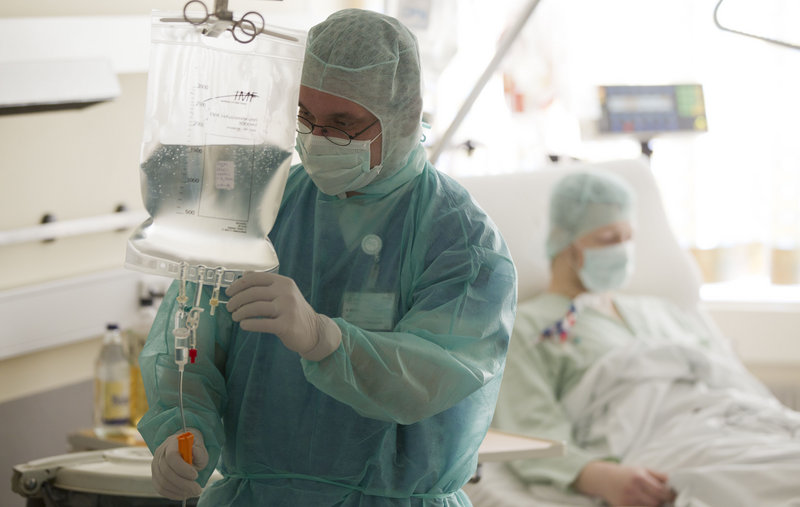HAMBURG, Germany — First they pointed a finger at Spanish cucumbers. Then they cast suspicion on sprouts from Germany. Now German officials appear dumbfounded as to the source of the deadliest E. coli outbreak in modern history, and one U.S. expert called the investigation a “disaster.”
Backtracking for the second time in a week, officials Monday said preliminary tests have found no evidence that vegetable sprouts from an organic farm in northern Germany were to blame.
The surprise U-turn came only a day after the same state agency, Lower Saxony’s agriculture ministry, held a news conference to announce that the sprouts appeared to be the culprit in the outbreak that has killed 22 people and sickened more than 2,330 others across Europe, most of them in Germany, during the past month.
Andreas Hensel, head of Germany’s Federal Institute for Risk Assessment, warned, “We have to be clear on this: Maybe we won’t be able anymore to identify the source.”
Last week, German officials pointed to tainted cucumbers from Spain as a possible cause, igniting vegetable bans and heated protests from Spanish farmers, who suffered heavy financial losses. Researchers later concluded the Spanish cucumbers were contaminated with a different strain of E. coli.
“This investigation has been a disaster,” Michael Osterholm, director of the Center for Infectious Disease Research and Policy at the University of Minnesota, told The Associated Press.
“This kind of wishy-washy response is incompetent,” he said, accusing German authorities of casting suspicion on cucumbers and sprouts without firm data.
The European Union’s health commissioner defended German investigators, saying they were under extreme pressure as the crisis unfolded.
“We have to understand that people in certain situations do have a responsibility to inform their citizens as soon as possible of any danger that could exist to them,” John Dalli said in Brussels.
In outbreaks, it is not unusual for certain foods to be suspected at first, then ruled out.
In 2008 in the United States, raw tomatoes were initially implicated in a nationwide salmonella outbreak. Consumers shunned tomatoes, costing the tomato industry millions. Weeks later, jalapeno peppers grown in Mexico were determined to be the cause.
In 2006, lab tests mistakenly pointed to green onions in an E. coli outbreak at Taco Bell restaurants in the United States. Investigators considered cheddar cheese and ground beef as the source before settling on lettuce.
With the culprit in the European crisis still a mystery, authorities stopped short of giving sprouts a clean bill of health. German Agriculture Minister Ilse Aigner reiterated the warning against eating sprouts, as well as tomatoes, cucumbers and lettuce, which have also come under suspicion.
The agriculture ministry for Lower Saxony said 23 samples from the organic sprouts farm tested negative for the highly aggressive, “super-toxic” strain of E. coli, with tests on 17 more samples still under way.
“A conclusion of the investigations and a clarification of the contamination’s origin is not expected in the short term,” the ministry said.
However, the negative test results do not mean that previous batches weren’t contaminated.
“Contaminated food could have been completely processed and sold by now,” ministry spokeswoman Natascha Manski said.
In that case, the number of people stricken might keep rising for at least another week as the produce that could be causing the infections may have already been delivered to restaurants and grocery stores.
More than 630 of the victims are hospitalized with a rare complication that can lead to kidney failure.
In a major difference from other E. coli outbreaks, women – who tend to eat more fresh produce – are by far the most affected this time, said the Robert Koch Institute, Germany’s national disease control center. The majority of them are between 20 and 50 years old and tend to be highly educated, very fit, and lead healthy lifestyles, said Friedrich Hagenmueller of Asklepios Hospital in Hamburg.
“What do they have in common? They are thin, clean, pictures of health,” he said.
Ulrike Seinsche is one of the women diagnosed with the serious complication that can lead to kidney failure.
“I really got scared when the blood results came and were so bad and the doctors became hectic,” she said from her hospital bed in Hamburg. She was quickly transferred into intensive care, got cramps and suffered “real death fear,” she said. “Now, I’m actually stable.”
Send questions/comments to the editors.



Success. Please wait for the page to reload. If the page does not reload within 5 seconds, please refresh the page.
Enter your email and password to access comments.
Hi, to comment on stories you must . This profile is in addition to your subscription and website login.
Already have a commenting profile? .
Invalid username/password.
Please check your email to confirm and complete your registration.
Only subscribers are eligible to post comments. Please subscribe or login first for digital access. Here’s why.
Use the form below to reset your password. When you've submitted your account email, we will send an email with a reset code.